“There’s a quiet power in building slowly, choosing to design for people before performance, and insisting that technology must first be kind, no matter how sleek”.
This belief guided my work at WAVE (West Africa Vocational Education), a nonprofit organisation focused on bridging the opportunity gap for unemployed youth in West Africa. We weren’t just teaching job skills, we were building belief and reminding young people, often failed by formal systems, that they mattered.
But purpose alone is never enough. Purpose needs a platform. And the real work lies in building the bridge between both.
When WAVE’s Learning Management System was launched, it wasn’t about trends. It was about reach. A classroom can hold only so many, but a device, even a borrowed one, can stretch across barriers of time, geography, and income. Many of our learners weren’t digital natives – some had never sent an email. So I built for empathy. I embedded celebration messages, visible progress bars, and reminders that didn’t feel robotic. Completion rates rose. More importantly, students stayed because the technology didn’t make them feel small. It made them feel possible.
I took the same approach to redesigning WAVE’s website. Not just to look good, but to show impact with clarity and respect. It became a window for donors, partners, and alumni. Real stories replaced sterile metrics. User journeys became simpler. Fundraising felt personal, not performative.
And behind the scenes? WAVE ran on tech: dashboards, tracking sheets, and automation tools. Our ROI wasn’t revenue, it was reach. We measured feedback, tracked job placements, and built systems that helped the mission run smoother and more fairly.
In the end, three lessons stayed with me.
First, design for dignity. For users who’ve been excluded, every UX decision speaks volumes. Second, marketing isn’t a megaphone; it’s a mirror. Tell true stories, in the voice of those living them. Third, your platform should amplify purpose, not distract from it. Flashy tools that complicate don’t belong in spaces that demand clarity.
Too often, we treat tech and purpose as opposing forces. But the future belongs to builders who can integrate both tools that are smart and soft, that automate but also affirm, that scale without shrinking users’ agency.
That’s what we tried to do at WAVE. And it’s what I carry into every digital strategy and product I help shape. Because when purpose meets platform in the right way, change doesn’t just happen. It lasts.
Daniel Ojeomokhai is a Product Marketing Manager who helps purposeful tech platforms grow through strategy, storytelling, and systems thinking. His work spans the tech, nonprofit, and retail sectors; always focused on building with empathy and context.






